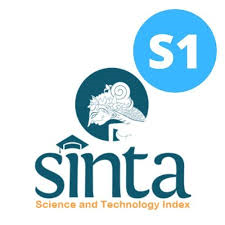MODELLING THE POTENTIAL DISTRIBUTIONS OF SAWO KECIK (MANILKARA KAUKI (L.)) DUBARD USING MAXENT TO SUPPORT CONSERVATIONS OF HISTORICAL AND CULTURAL VEGETATIONS IN DAERAH ISTIMEWA YOGYAKARTA PROVINCE
Abstract
Modelling the potential distributions of Sawo Kecik (Manilkara kauki (L.)) Dubard using MaxEnt to support conservations of historical and cultural vegeta-tions in Daerah Istimewa Yogyakarta Province. Reinwardtia 22(1): 55‒67. — Sawo kecik or Manilkara kauki (L.) Dubard, of the Sapotaceae family as it is formally known, is one of the species with significant cultural values in Yog-yakarta Province (DIY) culture because it symbolizes social righteousness. In connection with this, Yogyakarta's mu-nicipal and district governments have been encouraged to plant sawo kecik. Despite these efforts, there is still a lack of knowledge regarding the possible range of this species, and this knowledge is essential to promoting the conservation of M. kauki in DIY. With the help of isothermality, precipitation of driest month, precipitation seasonality, precipita-tion of driest quarter, and precipitation of warmest quarter data, this study tries to simulate the probable distributions of M. kauki throughout cities and districts in DIY. The model estimated 1,275 km2 of DIY areas was suitable for M. kauki that concentrated in the central parts, spanning from the west to the east of DIY. Yogyakarta City followed by Sleman District has the largest areas categorized from high to very high suitable for M. kauki. While, Gunung Kidul followed by Kulonprogo Districts have the largest areas categorized as low suitable. To conclude, M. kauki can adapt areas with moderate precipitation as low as 20 mm during driest month and as low as 100 mm during driest quarter. During warmest quarter, M. kauki requires precipitation with value of 700 mm. The conservation effort and M. kauki planting should then concentrate on Yogyakarta City and Sleman District since such locations are thought to have high appropriateness for the species.
Keywords
Full Text:
PDFReferences
ABDILLAH, A, SYAMSIYAH, J, RIYANTO, D. & MINARDI, S. 2011. The effect of zeolite and K
fertilizer on availability and K uptake at seashore sandy land of Kulonprogo, Yogyakarta. Bonorowo Wetlands 1: 1-7.
ANGGARA, O. C. & RAHMAWATI, L. A. 2021. the effectiveness of urban forest in absorbing CO2 emission at
Rajekwesi type A terminal. Jurnal Ilmu Lingkungan 1: 60-65.
ARSHAD, F, WAHEED, M, FATIMA, K, HARUN, N, IQBAL, M, FATIMA, K. & UMBREEN, S. 2022.
Predicting the suitable current and future potential distribution of the native endangered tree Tecomella undulata (sm.) seem. in Pakistan. Sustainability 14, 7215. 10.3390/SU1412721
BACKER, C. A. & VAN DEN BRINK, R. C. B.1963. Flora of Java (spermatophytes only) volume I.N.V.P.Noordhoff-Groningen, Netherlands.
BIVAND, R. 2022. R packages for analyzing spatial data: a comparative case study with areal data. Geographical Analysis 54. 10.1111/GEAN.12319.
CHAKRADHARI, S, DEB, M. K., PATEL, K. S., MARTÍN-GIL, J, TOWETT, E. K. & MARTÍN-RAMOS, P. Evaluation of the phytochemical and mineral characteristics of some selected sapotaceae plants. European Journal Of Medicinal Plant 27(4): 1-16,
CIPTANINGRUM, E. 2022. Evaluasi Kesuburan Tanah dengan Omission Trial N, P, K yang Ditambahkan Biochar pada Jagung Semi di Inceptisol, Kalibawang, Kulon Progo. Skripsi S1 Ilmu Tanah. Universitas Gadjah Mada.
CRUZ-RODRÍGUEZ, J. A., LÓPEZ-MATA, L. & VALVERDE, T. 2009. A. comparison of traditional elasticity and variance-standardized perturbation analyses: a case study with the tropical tree species Manilkara zapota (sapotaceae). Journal of Tropical Ecology 25(2).
DONG, H, ZHANG, N, SHEN, S, ZHU, S., FAN, S. & LU, Y. 2023. Effects of climate change on the spatial distribution of the threatened species Rhododendron purdomii in Qinling-Daba mountains of Central China: implications for conservation. Sustainability. 15(4), 3181. 10.3390/SU15043181
DUBARD, M. M. M. 1915. Annales Du Musee Coloniale De Marseille Ser. 3 3: 9.
FALASCA, S. L, PITTA-ALVAREZ, S. & ULBERICH, A. 2018. The potential growing areas for Argania spinosa (L.) Skeels (Sapotaceae) in Argentinean drylands. International Journal of Agronomy.
FOIS, M, CUENA-LOMBRAÑA, A, FENU, G. & BACCHETTA, G. 2018. Using species distribution models at a local scale to guide poorly known species, review: methodological issues and future directions. Ecol. Model. 385: 124-132. 10.1016/J.ECOLMODEL.2018.07.018.
HAKIM, L. & YULIAH. 2018. Peran B2P2BPTH Yogyakarta dalam pelestarian jenis jenis khas Daerah Istimewa Yogyakarta. Seminar Nasional Pendidikan Biologi dan Saintek III (2018): 329 - 337 (In Indonesian).
Hani, A, Indrajaya, Y, Suryanto, P. & Budiadi. 2016. Dry land agroforestry practices in Menoreh Hills, Kulonprogo. Agrivita 38(2).
HIJMANS, R. J., GUARINO, L. & MATHUR. P. 2012. Diva-GIS Version 7.5 Manual.
KHAN, A. M., LI, Q, SAQIB, Z, KHAN, N, HABIB, T, KHALID, N, MAJEED, M. & TARIQ, A. 2022. Maxent modelling and impact of climate change on habitat suitability variations of economically important chilgoza pine (Pinus gerardiana wall.) in South Asia. Forests 13, 715. 10.3390/F13050715.
KHANUM, R, MUMTAZ, A. & KUMAR, S. 2013. Predicting impacts of climate change on medicinal asclepiads of Pakistan using Maxent modeling. Acta Oecologica 49: 23-31. 10.1016/J.ACTAO.2013.02.007.
LEMENKOVA, P. 2020. Using R Packages 'tmap', 'raster' and 'ggmap' for cartographic visualization: an example of dem-based terrain modelling of Italy, Apennine Peninsula. Zbornik Radova - Geografski Fakultet Univerziteta U Beogradu. 68: 99-116. 10.5937/ZRGFUB2068099L.
MAO, M, CHEN, S, K. E/, Z, QIAN, Z. & XU, Y. 2022, Using Maxent to predict the potential distribution of the little fire ant (Wasmannia auropunctata) in China. Insects 13, 1008. 10.3390/INSECTS13111008.
MARCER, A, SÁE, L, MOLOWNY-HORAS, R, PONS, X. & PINO, J. 2013. Using species distribution modelling to disentangle realised versus potential distributions for rare species conservation. Biol. Cons. 166: 221-230. 10.1016/J.BIOCON.2013.07.001.
PARTOMIHARDJO, T, ARIFIANI, D, PRATAMA, B. A. & MAHYUNI, R.2014. Jenis – jenis pohon penting di hutan Nusakambangan.LIPI Press, Jakarta. (In Indonesian).
POHLAN, J, BORGMAN, J, GEHRKE-VELEZ, M. R. 2000. Perspectives of Sapotaceae species for fruit production in the Soconusco Region, Chiapas, Mexico. Acta Horticulturae. 10.17660/ActaHortic.2000.531.5
PROMNIKORN, K, JUTAMANEE, K. & KRAICHAK, E. 2019. Maxent model for predicting potential distribution of Vitex glabrata r.br. in Thailand. Agr Nat Resour. 53: 44-48.
PUTRA, Q. I. & NURJANI, E. 2021. Study of meteorological drought and its impact on rainfed paddy productivity in Gunung Kidul Regency. E3S Web Of Conferences. 325. 01017. 10.1051/E3SCONF/202132501017.
RANA, S. K., RANA, H. K., GHIMIRE, S. K, SHRESTHA, K. K. & RANJITKAR, S. 2017. Predicting the impact of climate change on the distribution of two threatened Himalayan medicinal plants of liliaceae in Nepal. J Mt. Sci. 14(3): 558-570. 10.1007/S11629-015-3822-1.
REDDY, M. T, BEGUM, H, SUNIL, N. PANDRAVADA, S. R. & SIVARAJ, N. 2015. Assessing climate suitability for sustainable vegetable roselle (Hibiscus sabdariffa var. sabdariffa l.) cultivation in India using Maxent. Agricultural and Biological Sciences Journal 1(2): 62-70.
SÁNCHEZ PÉREZ, M, FERIA ARROYO, T. P., VENEGAS BARRERA, C.S., SOSA-GUTIÉRREZ, C, TORRES, J., BROWN, K. A. & GORDILLO PÉREZ, G. 2023. Predicting the impact of climate change on the distribution of Rhipicephalus sanguineus in the americas. Sustainability 15 4557. 10.3390/SU15054557.
SEMU, A. A., BEKELE, T, LULEKAL, E., CARIÑANOS, P. & NEMOMISSA, S. 2021. Projected impact of climate change on habitat suitability of a vulnerable endemic Vvachellia negrii (pic.serm.) Kyal. & boatwr (Fabaceae) in Ethiopia. Sustainability 13, 1127510.3390/SU132011275.
SHCHEGLOVITOVA, M. & ANDERSON, R.P. 2013. Estimating optimal complexity for ecological niche models: a Jackknife approach for species with small sample sizes. Ecol. Model. 269: 9–17.
SOFIYANTI, E. & IRIANI, D. 2023. Anatomical, histochemical, and epidermal characteristic of Sawo Kecik (Manilkara kauki (L.) Dubard - sapotaceae) leaves. Jurnal Biologi Udayana. 27(1): 14-25
SONG, D, LI, Z, WANG, T, QI, Y, HAN, H. & CHEN, Z. 2023. Prediction of changes to the suitable distribution area of Fritillaria przewalskii maxim. in the Qinghai-Tibet plateau under Shared Socioeconomic Pathways (SSPS). Sustainability 15, 2833. 10.3390/SU15032833.
STEPHENSON, K., WILSON, B, TAYLOR, M, MCLAREN, K, VEEN, R, KUNNA, J. & CAMPBELL, J. 2022. Modelling climate change impacts on tropical dry forest fauna. Sustainability. 14(8): 10.3390/SU14084760
SUDRAJAT, D. & MEGAWATI, 2010. Keragaman morfologi dan respon perlakuan pra perkecambahan benih dari
lima populasi sawo kecik (Manilkara kauki (l.) Dubard. Jurnal Penelitian Hutan Tanaman 7: 67-76. 10.20886/JPHT.2010.7.2.67-76.
SUTARDI. 2017. Kajian minus one test dan kesuburan lahan pasir untuk budidaya tanaman bawang merah. Balai Besar Pengkajian dan Pengembangan Teknologi Pertanian. (In Indonesian).
VILÀ, M, GASSÓ, N, THUILLER, W. & PINO, J. 2012. Potential distribution range of invasive plant species in Spain. Neobiota 12: 25–40.
WEI, B, WANG, R, HOU, K., WANG, X. & WU, W. 2018. Predicting the current and future cultivation regions of Carthamus tinctorius using Maxent model under climate change in China. Global Ecology and Conservation 16.: E00477. 10.1016/J.GECCO.2018.E00477.
WIDAYATSARI, S. 2002. Tata ruang rumah bangsawan Yogyakarta. Dimensi Teknik Arsitektur 30(2): 122 – 13.
(In Indonesian).
ZHAO, W. L, CHEN, H .G, LIN, L, CUI, Z. J. & JIN, L. 2018. Distribution of habitat suitability for different
sources of Fritillariae cirrhosae bulbus. Chin. J. Ecol. 37: 1037–1042.
ZHU, G. P, GARIEPY, T. D, HAYE, T. & BU, W.J. 2017. Patterns of niche filling and expansion across the
invaded ranges of Halyomorpha halys in North America and Europe. J Pest Sci. 90: 1-13. 10.1007/s10340-016-0786-z

This work is licensed under a Creative Commons Attribution-ShareAlike 4.0 International License.
Refbacks
- There are currently no refbacks.









